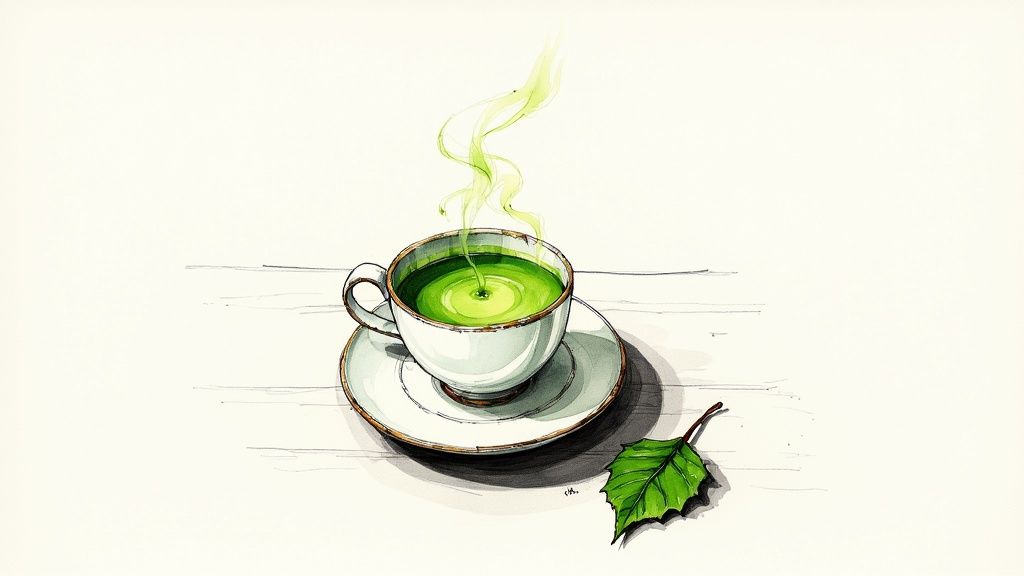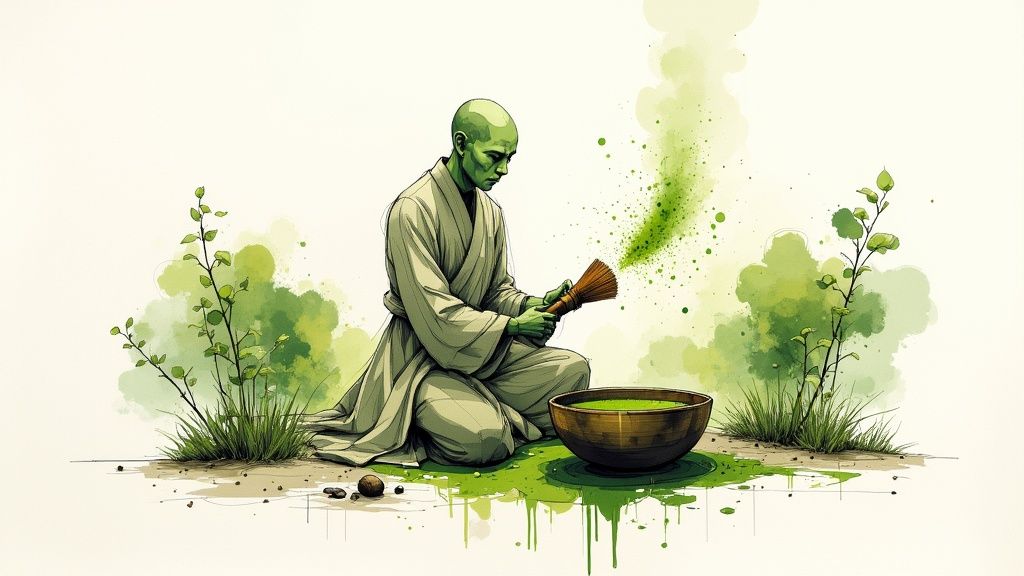The Unique Power of Matcha: Beyond Regular Green Tea

Matcha stands apart from regular green tea in meaningful ways. Its special growing methods, careful processing, and unique preparation create a tea that offers remarkable health benefits. Let's explore what makes matcha so special and how it differs from conventional green tea.
From Shade to Sip: Cultivating Superior Matcha
The magic of matcha begins several weeks before harvest when farmers shade the tea plants from direct sunlight. This traditional technique triggers changes in the leaves that boost their chlorophyll and L-theanine content. The increased chlorophyll gives matcha its bright green color, while the extra L-theanine contributes to its smooth, rich flavor. These shade-grown leaves also develop higher levels of beneficial compounds that set matcha apart from regular teas. The careful attention to growing conditions shows in every aspect of the final product – from its vivid color to its complex taste profile.
Whole Leaf Power: Maximizing Nutrient Intake
The key difference between matcha and regular green tea lies in how we consume it. Rather than steeping and discarding the leaves, matcha involves drinking the entire tea leaf in powdered form. This means you get the full nutritional benefits of the whole leaf, including all its vitamins, minerals, and antioxidants. When you whisk matcha powder into water or milk, you break down the leaf's cell walls, making these nutrients even more available for your body to absorb. This simple difference makes matcha more nutritionally potent than steeped green tea. For more details about these benefits, check out: Exploring the Amazing Advantages of Matcha Tea.
The Synergistic Trio: L-Theanine, Catechins, and Caffeine
Matcha delivers a unique combination of three key compounds that work together in your body. The L-theanine promotes calmness, while caffeine provides energy, creating a balanced state of alert relaxation without jitters or crashes. Meanwhile, catechin antioxidants help protect your cells from damage. This natural blend explains why many people find matcha gives them steady energy and mental clarity that lasts for hours.
Quality Matters: Identifying Superior Matcha
The benefits you get from matcha depend greatly on its quality. Top-grade matcha comes from carefully selected tea plants grown in ideal conditions and processed with expert care. Look for these signs of quality: a bright green color, smooth texture, and naturally sweet taste with subtle umami notes and minimal bitterness. Choose organic matcha from established suppliers to ensure you're getting pure, properly produced tea that delivers the full range of health benefits. The extra attention to quality makes a real difference in both taste and effectiveness.
Mental Clarity and Focus: Your Brain on Matcha
More people are discovering matcha not just for its rich green color and distinctive taste, but for the remarkable mental boost it delivers. The experience is notably different from coffee – instead of a quick jolt followed by jitters, matcha provides a smooth, lasting sense of alertness. Let's explore exactly how matcha affects your brain and cognitive function.
The Dynamic Duo: L-Theanine and Caffeine
At the heart of matcha's cognitive benefits are two key compounds that work together beautifully: L-theanine and caffeine. L-theanine is an amino acid found mainly in tea leaves that creates a sense of calm without making you drowsy – similar to the mental state achieved during meditation. When combined with caffeine's energizing properties, the result is a balanced state of alert tranquility. You get the mental sharpness to tackle complex tasks while maintaining a sense of ease and steadiness.
A Steady Stream of Focus: No Crash Zone
This balanced interaction is what makes matcha so different from coffee. Rather than experiencing an intense spike of energy followed by a crash, matcha's caffeine is gradually released over 4-6 hours thanks to L-theanine's moderating effect. Picture the difference between a bright flash that quickly fades versus a steady flame that burns consistently. This sustained energy helps you maintain focus and productivity throughout your day, making it ideal for long work sessions or studying.
Optimizing Your Matcha for Peak Mental Performance
To get the most mental clarity from your matcha, timing and portion size matter. Many find that starting their day with matcha sets them up for sustained focus. A second cup in the early afternoon can help prevent the post-lunch energy dip that many experience. As for serving size, begin with a small amount (½ – 1 teaspoon of powder) and adjust based on how your body responds. Pay attention to how you feel and find the amount that works best for your needs.
Matcha: The Modern Elixir for Mental Acuity
The evidence for matcha's cognitive benefits continues to grow. Its ability to provide clear-headed focus and sustained energy without the downsides of coffee makes it an excellent choice for improving mental performance. Whether you need to concentrate on detailed work, study for exams, or simply want to feel more mentally sharp throughout your day, matcha can be a valuable addition to your routine. Understanding how its natural compounds support brain function allows you to make the most of this traditional tea for modern cognitive demands.
Heart Health Benefits: Supporting Your Cardiovascular System

When it comes to heart health, matcha offers some compelling benefits worth exploring in detail. Understanding how this unique tea supports cardiovascular wellness can help you make informed choices about including it in your daily routine.
The Power of Antioxidants: Protecting Your Heart
The bright green color of matcha comes from its high concentration of beneficial compounds, especially catechins. These natural antioxidants help protect your cells from damage caused by free radicals, which can lead to heart problems over time. One standout compound is epigallocatechin gallate (EGCG), which research shows may help prevent heart disease by improving blood flow and reducing inflammation – two key factors for a healthy heart.
Maintaining Healthy Cholesterol: A Balancing Act
Managing cholesterol levels is essential for heart health, and matcha appears to help with this important task. Research has found that drinking matcha regularly may help lower LDL (bad) cholesterol while boosting HDL (good) cholesterol. This balance helps keep your arteries clear and reduces your risk of serious issues like heart attacks and strokes. Adding matcha to your daily habits could be a simple way to support healthy cholesterol naturally.
Blood Pressure Regulation: Keeping It in Check
Your blood pressure plays a major role in heart health, and studies suggest matcha can help maintain healthy levels. The beneficial compounds in matcha work together to support proper blood vessel function while fighting inflammation. Some studies have found that people who drink matcha often tend to have lower blood pressure readings, pointing to another way this tea benefits heart health.
Beyond the Basics: Complete Heart Support
The heart benefits of matcha come from more than just its individual components. It's the combination of antioxidants, L-theanine, and other nutrients working together that makes matcha so good for cardiovascular health. When you make matcha part of an overall heart-healthy lifestyle, you're supporting your cardiovascular system in multiple ways – from maintaining good cholesterol to regulating blood pressure and protecting cells. The L-theanine in matcha may even help reduce stress, which also impacts heart health. These combined benefits make matcha a great choice for anyone looking to take care of their heart naturally.
Metabolism and Weight Management Success
Matcha tea does more than support heart health – it's also an excellent ally for anyone looking to manage their weight and improve their metabolism. Let's explore the research-backed connections between drinking matcha and maintaining a healthy weight.
The Thermogenic Power of Matcha
One of matcha's key weight management benefits comes from its ability to boost metabolism naturally. When you drink matcha, your body becomes more efficient at burning calories, even when you're resting. This effect comes from two main compounds working together – caffeine and EGCG (a type of catechin). The caffeine helps increase energy use, while EGCG promotes fat burning. Together, they help your body burn calories more effectively throughout the day.
Enhanced Fat Burning for Optimal Results
When it comes to weight loss specifically, matcha shines in its ability to target fat cells. Rather than just increasing overall metabolism, matcha helps your body break down and use fat for energy. This means you may notice better results in reducing body fat, especially when you combine matcha with regular exercise. Think of it as giving your body an extra tool to burn fat more efficiently.
Matcha and Exercise: A Winning Combination
Adding matcha to your pre-workout routine can help boost your results. Having matcha before exercising helps your body access fat stores for fuel during your workout. The steady energy from matcha can also help you exercise longer and perform better, since you won't experience the sudden crash that comes with other caffeinated drinks.
Supporting Healthy Blood Sugar Levels
Matcha also helps keep blood sugar levels steady throughout the day. This is key for weight management since blood sugar spikes and crashes often lead to cravings and overeating. By helping regulate blood sugar, matcha supports more consistent energy levels and fewer cravings, making it easier to stick to healthy eating habits. Additionally, matcha supports gut health through its natural prebiotic properties. A healthy gut microbiome plays an important role in metabolism and maintaining a healthy weight, so matcha's benefits for digestive health further support overall weight management goals.
Antioxidant Defense: Your Daily Protection Plan

We've explored matcha's antioxidant content earlier, but now let's take a closer look at exactly how these compounds protect your health and what makes matcha stand out as such a beneficial drink. Understanding these specifics helps explain why matcha deserves a place in your daily routine.
Understanding the Power of Antioxidants
Think of antioxidants as your body's security team, constantly working to neutralize harmful molecules called free radicals. These free radicals naturally occur during normal processes like metabolism, but they can also build up from environmental factors such as pollution and poor diet. When free radicals accumulate, they can damage your cells and speed up aging. Antioxidants step in to prevent this damage by stopping free radicals before they can harm your cells. They act like microscopic shields, protecting your body's cells from ongoing attacks.
Matcha: A Rich Source of Protective Catechins
What makes matcha special is its high concentration of catechins, particularly a powerful one called epigallocatechin gallate (EGCG). Research shows that EGCG in matcha is about 137 times more concentrated than in regular green tea. This remarkable difference comes from the unique way matcha is grown – farmers shade the tea plants before harvest, which causes the leaves to produce more of these beneficial compounds. Each cup of matcha gives you a concentrated dose of these protective nutrients.
The Antioxidant Benefit of Matcha: Beyond EGCG
The protective power of matcha doesn't stop at EGCG. It contains a mix of different compounds that work together to defend your cells. For example, matcha provides substantial amounts of vitamins A and C, which also fight free radicals in their own way. These nutrients team up to create a strong defense system that helps prevent cell damage and supports your overall health.
Practical Applications of Matcha's Antioxidant Power
The health benefits of matcha's antioxidants are wide-ranging and backed by research. Regular matcha drinking may help slow down cellular aging and reduce your risk of various health problems linked to oxidative damage. The antioxidants in matcha can even help protect your skin from sun damage and environmental stress. By making matcha part of your daily habits, you're taking a simple but effective step to protect your health from the inside out. Whether you sip it hot or cold, each cup of matcha supports both your immediate and long-term wellbeing.
Maximizing Your Matcha: Practical Implementation Guide

Understanding how to properly prepare and integrate matcha into your daily routine makes all the difference in experiencing its full benefits. Let's explore practical ways to make matcha a natural part of your lifestyle.
Mastering the Art of Matcha Preparation
The preparation method you choose affects both the taste and effectiveness of your matcha. While the traditional approach offers a meditative ritual, modern tools provide quick and convenient options.
-
Traditional Whisking: Start by sifting matcha powder into a warmed bowl to prevent clumps. Add hot water at about 175°F (not boiling), then use a bamboo whisk (chasen) to blend in a "W" or "M" pattern until frothy. Complete by adding remaining water and whisking gently.
-
Modern Methods: Electric whisks and frothers offer a quick way to achieve smooth matcha. For iced drinks, try a shaker bottle – just combine matcha, water, and optional add-ins, then shake well. Both methods produce results similar to traditional whisking.
Timing Your Matcha Intake for Optimal Results
When you drink matcha can significantly impact its effects. Here's how to time your matcha moments throughout the day:
-
Morning Energy Boost: Start your day with matcha instead of coffee. The combination of caffeine and L-theanine provides steady energy without jitters.
-
Afternoon Pick-Me-Up: Beat the post-lunch slump with a cup of matcha. It's more nourishing than sugary snacks and won't disrupt your sleep like afternoon coffee.
-
Pre-Workout Fuel: Drink matcha before exercise to improve focus and stamina. The balanced energy helps you maintain intensity throughout your workout.
Exploring Culinary Creations with Matcha
Matcha's rich flavor and bright color make it perfect for both drinks and food. Here are some ways to enjoy it beyond traditional tea:
-
Matcha Lattes: Mix with your choice of milk – almond, oat, or coconut each adds its own unique flavor.
-
Smoothies and Bowls: Add a spoonful to your morning blend or breakfast bowl for extra nutrients and sustained energy.
-
Baking Projects: Use matcha in cakes, cookies, and pastries. Keep in mind that high heat can reduce some benefits, so choose recipes with moderate baking temperatures.
-
Savory Dishes: Try matcha in noodles, soups, or sauces. Its earthy notes pair especially well with umami flavors.
Selecting and Storing Your Matcha
Quality matcha should have a vibrant green color, fine texture, and fresh, sweet smell. Choose ceremonial grade for the best flavor and highest quality. Keep your matcha in an airtight container away from light and heat, or store it in the fridge. Good storage helps maintain freshness and potency over time.
Ready to start your matcha journey? Visit matcha-tea.com to browse their selection of premium matcha. Begin experiencing the benefits of this remarkable tea today!
